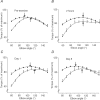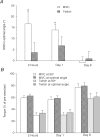Length-dependent changes in voluntary activation, maximum voluntary torque and twitch responses after eccentric damage in humans
- PMID: 16357013
- PMCID: PMC1805656
- DOI: 10.1113/jphysiol.2005.101600
Length-dependent changes in voluntary activation, maximum voluntary torque and twitch responses after eccentric damage in humans
Abstract
To assess the contribution of central and peripheral factors to changes in maximum voluntary force and its length dependence after eccentric muscle damage, voluntary and twitch torque were measured across a wide angular range, along with voluntary activation using twitch interpolation. Isometric torque from both maximum voluntary contractions (MVCs) and paired twitches to motor nerve stimulation were measured from 60 to 150 deg elbow flexion in 10 deg increments in eight subjects. Optimal angles were determined by curve fitting. Each subject then performed eccentric contractions until voluntary torque had decreased by approximately 40%. Measurements were repeated at 2 h, 1 day and 8 days post-exercise to follow acute and longer-term changes. Before exercise, the optimal angle was in the mid-range (93+/-10 deg; mean+/-s.d.) for MVCs, and at a more extended elbow angle for the twitch (106+/-6 deg, P < 0.05). Voluntary activation was generally high (> 94%) but depended on elbow angle, with activation being approximately 4% lower at the most flexed compared to the most extended angle. Two hours after exercise, MVCs decreased 40%, while twitch torque declined 70%. All subjects showed a shift in optimal angle to longer muscle lengths for MVCs (17+/-16 deg at 2 h, 14+/-7 deg at day 1, P < 0.05). This shift contributed minimally (approximately 3%) to the reduction in torque at 90 deg, as the torque-angle relation was relatively flat around the optimum. The twitch showed a smaller shift (approximately 4 deg) to longer lengths which was not statistically significant. Voluntary activation was significantly impaired in the early stages after exercise (2 h and day 1, P < 0.05), particularly at short muscle lengths. By 8 days after exercise, the optimal angle had returned to pre-exercise values, but MVC, twitch torque and voluntary activation had not fully recovered. Eccentric exercise causes a short-term shift in the optimal angle for MVCs and produces a length-dependent impairment in voluntary activation. Therefore, it appears that both central and peripheral factors limit muscle performance following eccentric damage, with limits to voluntary drive being especially important at short lengths.
Figures






References
-
- An KN, Hui FC, Morrey BF, Linschied RL, Chao EY. Muscles across the elbow joint: a biomechanical analysis. J Biomech. 1981;14:659–669. - PubMed
-
- An KN, Kaufman KR, Chao EY. Physiological considerations of muscle force through the elbow joint. J Biomech. 1989;22:1249–1256. - PubMed
-
- Babault N, Pousson M, Michaut A, Van Hoecke J. Effect of quadriceps femoris muscle length on neural activation during isometric and concentric contractions. J Appl Physiol. 2003;94:983–990. - PubMed
Publication types
MeSH terms
LinkOut - more resources
Full Text Sources
Medical

